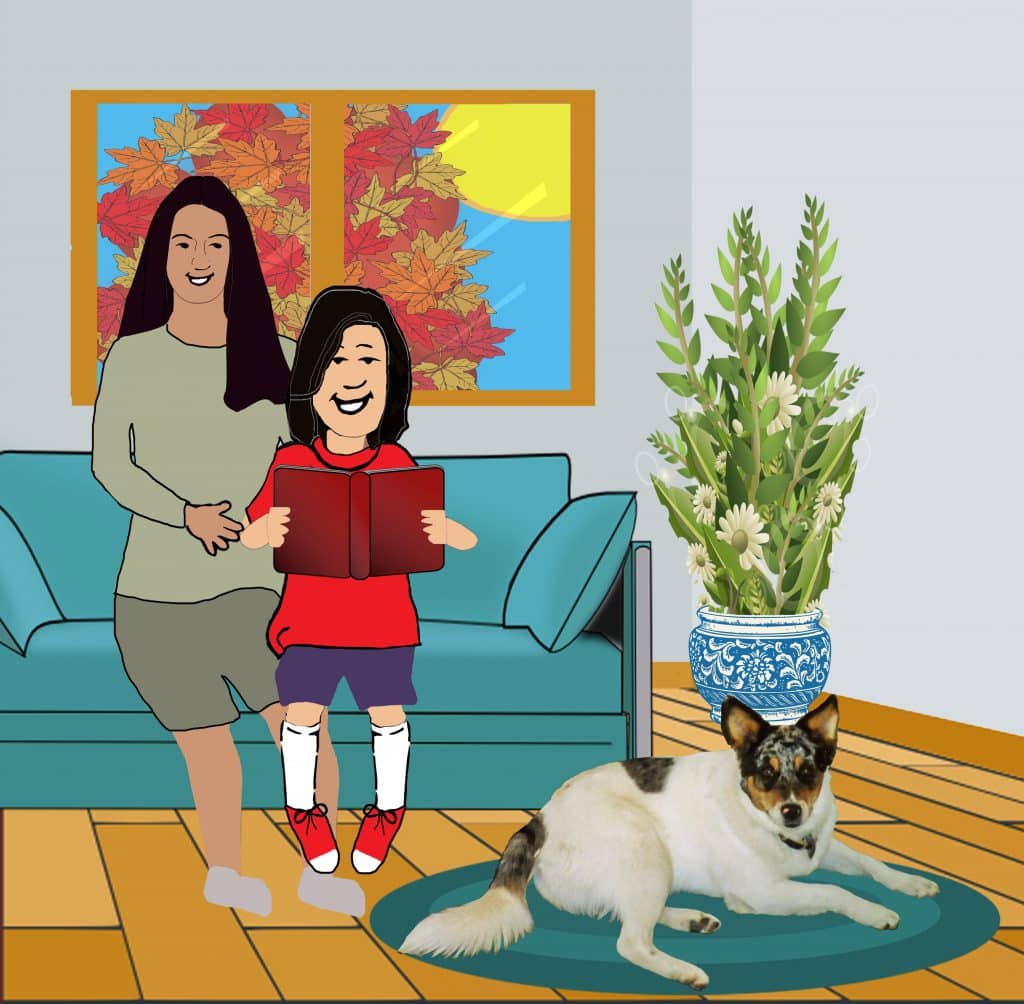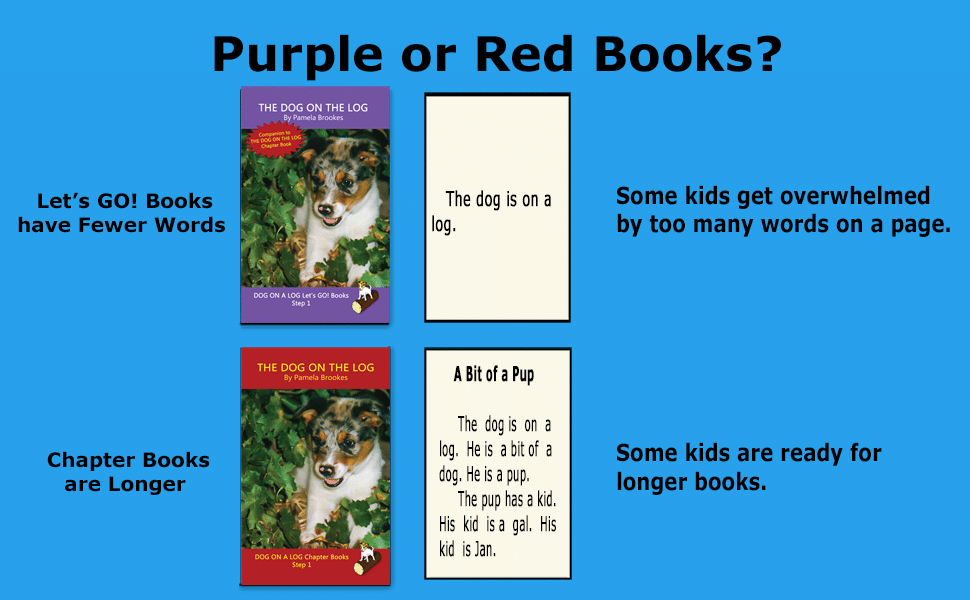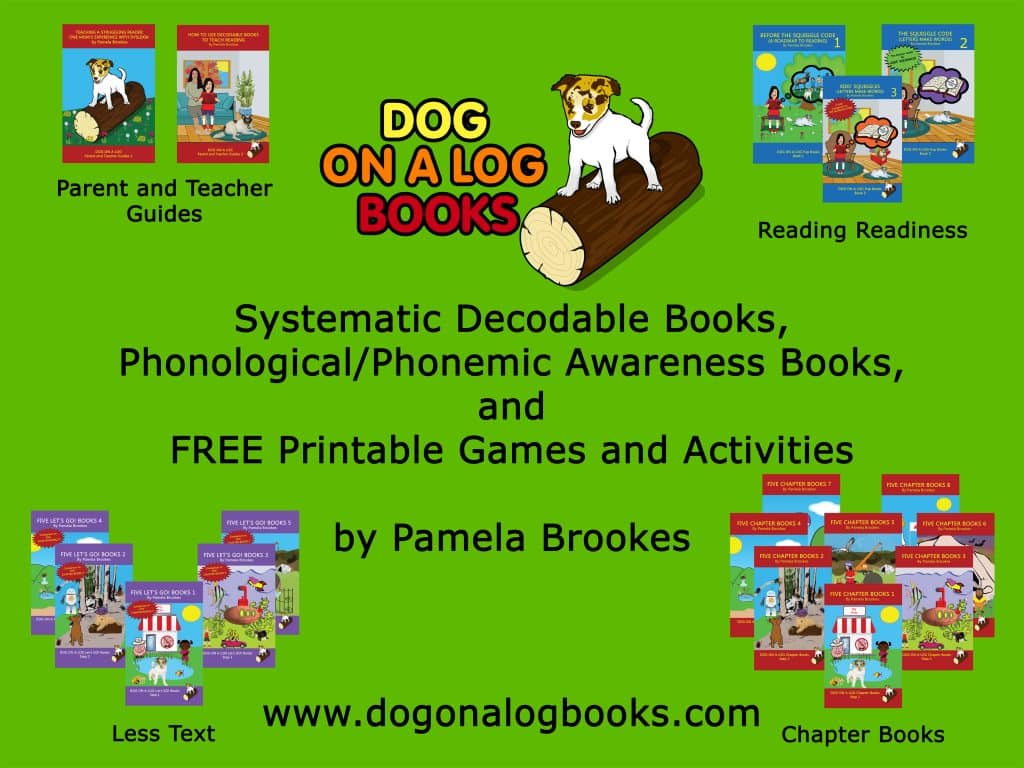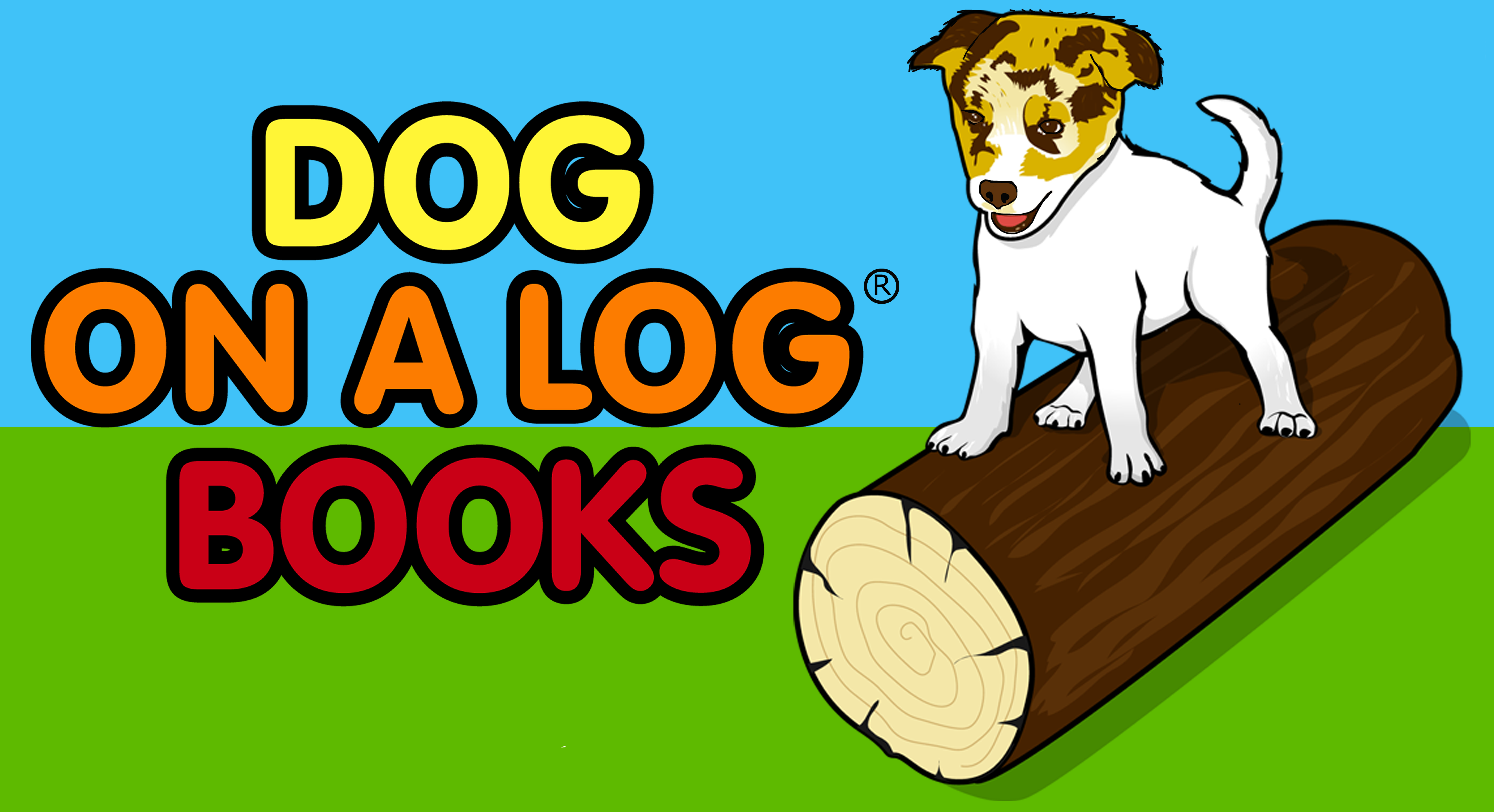
I’m hearing from families, librarians, and teachers that they want to know how to use DOG ON A LOG Books to teach their child to read. This is an excerpt from the booklet titled “How to Use Decodable Books to Teach Reading” answers that.
Where in the Series do We Start?
This will vary depending on the text or books you are using. If you are using a different series of books, you will need to look at their Phonics Progression which may also be called the Scope and Sequence. Where in a series you precisely start with will depend on what your child has been taught and what they have mastered. If they’re not reading at all, you will want to start with phonological and phonemic awareness skills.
I have written a Parent-friendly series of books called DOG ON A LOG Pup Books. The first book in that series is called Before the Squiggle Code. It is the book you will want to start with if your child is not reading at all.
Even if your child is reading some, but they are struggling, you may want to consider starting with a book like Before the Squiggle Code. I have been teaching reading to some kids in a homeschool co-op phonics class. Although each had started learning to read before I began working with them, I started the class at the very beginning by using Before the Squiggle Code. All the kids gained a lot from that book and all the associated games we played. One child learned how to rhyme, another was started hearing the syllables in words. All of them got a lot out of learning how to “tap” the sounds in words. “Tapping” is such an important skill that I talk about it in all three of my other non-fiction books and I will include that information in the excerpts at the end of this book.
My co-op phonics class was offered in the spring. Over the following summer one of the kids had a huge reading spurt. His mom credits what he learned from Before the Squiggle Code for helping him gain so many reading skills in the three months following that class. If I hadn’t done that “remedial” work with him since he was already reading some, he may not have developed the very basic skills he needed to help him get good at reading. When I used the DOG ON A LOG Quick Assessment Tool with him when he prepared to start the fall semester, I discovered he had gone from not reading to reading every word on the tool. That’s pretty unusual, but I was so pleased. He ended up taking a different class as he clearly did not need additional phonics instruction from me.
If you are uncertain whether your child could benefit from the very first skills in Before the Squiggle Code, you may wish to make sure they have mastered them. You can do this by using a phonemic awareness screening tool. I looked at several, but most are not written for parents. They can be easy to use, but they don’t list by what age a child should be mastering a skill. As a parent, I found this screener the easiest to understand. It costs just a few dollars, to download: Phonemic Awareness and Dyslexia Screening Tool. It can be used after the first 9 weeks of kindergarten.
This particular screening tool also includes asking children to say the names of letters. If they haven’t been taught the letter names, (which is what they will learn in The Squiggle Code,) they would not, of course, get that portion of the assessment correct.
I have been told that, since every child develops at their own pace, it may be perfectly normal for kids to master any of these skills later than other children. However, if your child is still not mastering skills 6 to 12 months after other kids have mastered them, you should probably contact a dyslexia or learning disabilities specialist.
Angie Neal, M.S., CCC-SLP, the developer of the tool messaged me, “These are average age ranges. That means it wouldn’t be considered ‘disordered’ unless they are significantly behind. I would consider 6 months behind as delayed and a year or more behind as disordered. I would not consider one skill as a single predictor, but I would be sure to support development of that skill through reading and word play frequently.”
If your child has not mastered all the skills in Angie Neal’s screener, I recommend you start with the first DOG ON A LOG Pup Book, Before the Squiggle Code.
If your child has the skills in that screener, the next questions are if they know the letters and their sounds and if they can blend them together to make words. If they can, then you can probably skip the second Pup Book, The Squiggle Code. The letter sounds they need to know are described later in the section on Individual Phonics Rules.
If your child doesn’t know the letter sounds and can’t blend them or sound them out in words, then The Squiggle Code will help you teach them those skills.
To help teach the skills in both Pup Books, I have all kinds of syllable games, letter flashcards, keyword tables, and other printable pre-reading activities that you can download for free.
If your child knows the short vowel and primary consonant sounds and how to blend them into words, then look at the following phonics progression. (I am including the skills from the Pup Books as well.) There is a quick assessment tool after the progression list. If the phonics list is too confusing, just skip it and go straight to the DOG ON A LOG Quick Assessment.
DOG ON A LOG Books, are written so that most of the books are independent stories so your child will not miss an important plot point if they don’t start with Book 1. Beginning in Step 9, there are mini-series within the series, such as a five-book mystery that spans five Steps of phonics. Those books will be clearly labeled as part of a mini-series.
DOG ON A LOG Phonics Progression
DOG ON A LOG Pup Books
Book 1
Phonological/Phonemic Awareness:
Words
Rhyming
Syllables, identification, blending, segmenting
Identifying individual letter sounds
Books 2-3
Phonemic Awareness/Phonics
Consonants, primary sounds
Short vowels
Blending
Introduction to sight words
DOG ON A LOG Let’s GO! and Chapter Books
Step 1
Consonants, primary sounds
Short vowels
Digraphs: ch, sh, th, wh, ck
2 and 3 sound words
Possessive ‘s
Step 2
Bonus letters (f, l, s, z after short vowel)
“all”
–s suffix
Step 3
Letter Buddies: ang, ing, ong, ung, ank, ink, onk, unk
Step 4
Consonant blends to make 4 sound words
3 and 4 sound words ending in –lk, -sk
Step 5
Digraph blend –nch to make 3 and 4 sound words
Silent e, including “-ke”
Step 6
Exception words containing: ild, old, olt, ind, ost
Step 7
5 sounds in a closed syllable word plus suffix -s (crunch, slumps)
3 letter blends and up to 6 sounds in a closed syllable word (script, spring)
Step 8
Two syllable words with 2 closed syllables, not blends (sunset, chicken, unlock)
Step 9
Two syllable words with all previously introduced sounds including blends, exception words, and silent “e” (blacksmith, kindness, inside)
Vowel digraphs: ai, ay, ea, ee, ie, oa, oe (rain, play, beach, tree, pie, goat, toe)
Step 10
Open syllables including y as the long vowel sound “I” (be, so, dry)
2 syllable words containing:
Open syllables (beside, recall, myself)
Previously learned sight words (outside, somewhere)
vowel teams ai, ea, ee, ie, oa, oe (raindrop, sixteen)
DOG ON A LOG Quick Assessment
This assessment is specifically for DOG ON A LOG Books. If you are using a different series, you will need to use their resources to determine where in their series to start.
To help you figure out what Step of DOG ON A LOG Books might be the best starting point for your child, have them read the following lists of words. This list of words is also available as an assessment tool. Start with Step 1. If they get all of the words correct, go on to Step 2. Continue until they reach a Step where they miss one or more words. That is the Step you should probably start with. If they struggle with this Step, you can always move back a Step.
Or you may want to start with a Step where your child is able to read the complete set of words. Let them practice and build confidence.
Regarding skipping steps:
The DOG ON A LOG Books are systematic and sequential. That means the steps build upon each other. Skipping a Step that your child has not mastered could be problematic as they will struggle when they encounter those words in future steps.
An example of when it might work to skip a Step would be if they had already mastered one step, but not a prior one. For example, let’s say they have mastered Steps 1 and 2 as well as consonant blends (Step 4,) but not letter buddies with ng or nk (Step 3.) In that example, you would have them read and master Step 3 then consider skipping Step 4.
The printable assessment tool includes a word list in columns as well as rows.
Step 1
fin, mash, sock, sub, cat, that, Dan’s
Step 2
less, bats, tell, mall, chips, whiff, falls
Step 3
bangs, dank, honk, pings, chunk, sink, gong, rungs
Step 4
silk, fluff, smash, krill, drop, slim, whisk
Step 5
hunch, crate, rake, tote, inch, mote, lime
Step 6
child, molts, fold, hind, jolt, post, colds
Step 7
strive, scrape, splint, twists, crunch, prints, blend
Step 8
finish, denim, within, bathtub, laptop, medic, habit
Step 9 (in production)
hundred, goldfinch, free, wheat, inhale, play, Joe
Step 10 (upcoming)
be, remake, spry, repeat, email, sometime, pinwheel
Figuring It Out
Which of those rules and words does your child know? If they don’t know the digraphs in Step 1, then start there. If they know the rules in Steps 1-4 but not Step 5, then start at Step 5 or maybe Step 4.
Something that could be a little challenging is that each phonics program teaches the phonics rules in a different order. When I was first writing DOG ON A LOG Books I was really worried about that. I wanted to write books that could be used by anyone learning to read. The reality is that unless a teacher is using the specific DOG ON A LOG phonics progression, you will have to choose the Step of books that is most appropriate for your child and you will have to make sure they know all the phonics rules and sight words in that book before they start reading it. It could be that the DOG ON A LOG phonics progression is too different from what your child has been taught and you may need to find a different set of books for the moment.
The DOG ON A LOG phonics progression is developed by my daughter’s teacher for MY daughter. We then adapt the progression to make sure it makes sense for as many other learners as we can. I wish that I could meet the needs of every single person learning to read, but that really isn’t possible. Every learner has individual needs. Sometimes that means DOG ON A LOG Books are exactly what they need. Other times it means they will have to take a break from my books and come back at a different time. The important thing is that the teacher (whether that’s a trained teacher or a parent) must figure out what the best choice is for that specific learner.
We Know What Step of DOG ON A LOG Books, Now What?
If your child is in the very beginning stages included in Before the Squiggle Code and The Squiggle Code, those books are detailed and will give you guidance. I will not go into detail about the topics included in those books.
If your child is ready for Step 1 or later books, let’s talk.

If your child is in Steps 1-5, you can choose between chapter books and Let’s GO! Books. For some kids, the RED chapter books are really intimidating because they have so many words. The very first chapter book has 260 words! To help new readers get used to reading so much, I have the PURPLE Let’s GO! Books. They tell the same story and have the same pictures as the chapter books, but don’t have so many words. The very first Let’s GO! Book only has 50 words. If your child resists reading a red chapter book, you may find it helpful to read the purple Let’s GO! Book. Then you can say, “You did so well with that. You know the story and you know how to read those words. Let’s try the chapter book. We’ll go slow. You don’t need to read the whole book in one sitting.”
The earliest DOG ON A LOG Books are simple stories and the sentences can seem a bit awkward because the vocabulary is so limited. Most kids (like one of the 10-year-old boys I am teaching,) are so thrilled to be reading that they don’t care about the simplicity of the stories, all they care about is they are able to read an entire 50- or 260-word book.
I do want to let you know that some kids will complain that Step 1 books are “baby books.” My daughter’s tutor says that’s common for slightly older kids to say about all really early books like that. Sometimes it is because the stories really are simple. Other times it might be a bit of bravado. They can tell the books are simple stories and may be intimidated that they will struggle with them and they don’t want to be embarrassed. Ultimately, once struggling readers read them, they tend to stop saying they are baby books.
Should your child make that statement, let them know that the Step 2 books aren’t quite so simplistic and that each Step after that the stories get more complicated. (And in Step 9, which isn’t published yet, I am creating a five-book mystery!)
If you think that your child may resist reading the Step 1 books because the books seem so “young,” you can try starting with Step 2. I will caution you about that, though. There is another series of decodable books that are much more advanced than the earliest DOG ON A LOG Books. They’re wonderful books and I was excited to introduce my daughter to them. They were beyond her abilities but I figured I’d help her with the words she couldn’t sound out. Sigh. That backfired miserably. She got to words she couldn’t read and refused to read any more. She now has the ability to read those books on her own but won’t. I am so frustrated because she needs books beyond just mine and the only other decodable books that are affordable, she won’t read.


